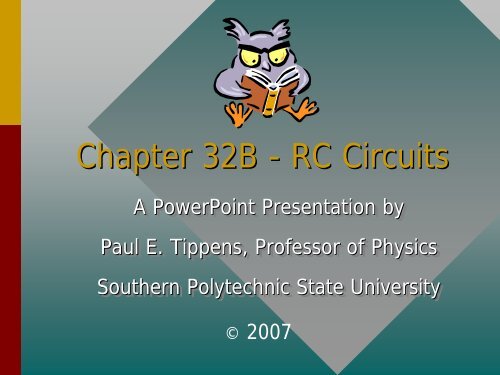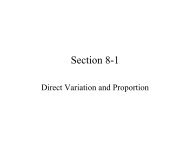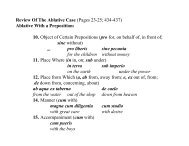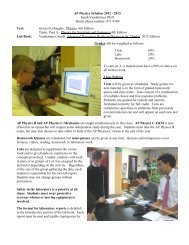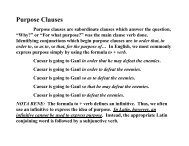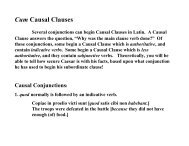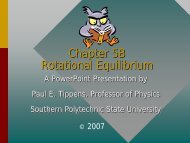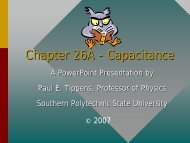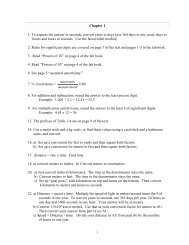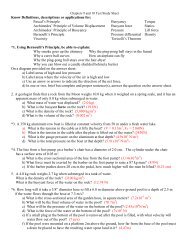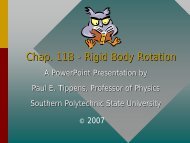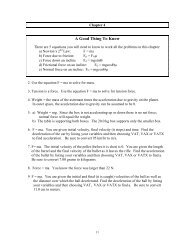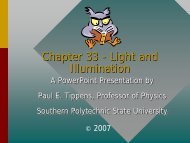RC Circuits.pdf
RC Circuits.pdf
RC Circuits.pdf
You also want an ePaper? Increase the reach of your titles
YUMPU automatically turns print PDFs into web optimized ePapers that Google loves.
Chapter 32B - <strong>RC</strong> <strong>Circuits</strong><br />
A PowerPoint Presentation by<br />
Paul E. Tippens, Professor of Physics<br />
Southern Polytechnic State University<br />
© 2007
<strong>RC</strong> <strong>Circuits</strong>: The rise and decay<br />
of currents in capacitive circuits<br />
Optional: Check with Instructor<br />
The calculus is used only for derivation of<br />
equations for predicting the rise and decay<br />
of charge on a capacitor in series with a<br />
single resistance. Applications are not<br />
calculus based.<br />
Check with your instructor to see if this<br />
module is required for your course.
V<br />
<strong>RC</strong> Circuit<br />
<strong>RC</strong>-Circuit: Resistance R and capacitance C<br />
in series with a source of emf V.<br />
a R<br />
a R<br />
b<br />
+<br />
+<br />
-<br />
-<br />
C<br />
V<br />
b<br />
i<br />
+<br />
+<br />
-<br />
-<br />
C<br />
q<br />
C<br />
Start charging capacitor. . . loop rule gives:<br />
<br />
E<br />
q<br />
iR;<br />
V iR<br />
C
V<br />
<strong>RC</strong> Circuit: Charging Capacitor<br />
a<br />
b<br />
R<br />
i<br />
+<br />
+<br />
-<br />
-<br />
C<br />
q<br />
C<br />
Rearrange terms to place in differential form:<br />
Multiply by C dt :<br />
R<br />
V<br />
<br />
dq<br />
dt<br />
q<br />
C<br />
<br />
V<br />
<br />
<br />
iR<br />
q<br />
C<br />
<strong>RC</strong>dq ( CV q)<br />
dt<br />
dq dt q dq<br />
t dt<br />
<br />
( CV q)<br />
<strong>RC</strong> 0 ( CV q)<br />
o <strong>RC</strong>
V<br />
<strong>RC</strong> Circuit: Charging Capacitor<br />
a<br />
b<br />
R<br />
i<br />
+<br />
+<br />
-<br />
-<br />
C<br />
ln( CV q) ln( CV ) <br />
q<br />
q dq<br />
t dt<br />
<br />
C 0 ( CV q)<br />
o <strong>RC</strong><br />
ln( CV q) q <br />
t<br />
0<br />
<strong>RC</strong><br />
t<br />
<strong>RC</strong><br />
( )<br />
ln CV q <br />
<br />
t<br />
CV <strong>RC</strong><br />
CV q CVe (1/ <strong>RC</strong>)<br />
t<br />
<br />
qCV 1e<br />
t/<br />
<strong>RC</strong>
<strong>RC</strong> Circuit: Charging Capacitor<br />
V<br />
a<br />
b<br />
R<br />
i<br />
+<br />
+<br />
-<br />
-<br />
C<br />
q<br />
C<br />
Instantaneous charge q<br />
on a charging capacitor:<br />
<br />
q CV 1e t/<br />
<strong>RC</strong><br />
<br />
At time t = 0: q = CV(1 - 1); q = 0<br />
At time t = : q = CV(1 - 0); q max = CV<br />
The charge q rises from zero initially to to<br />
its maximum value q max max<br />
= CV CV
Example 1. What is the charge on a 4-F<br />
capacitor charged by 12-V for a time t = <strong>RC</strong><br />
Q max<br />
0.63 Q<br />
q<br />
Capacitor<br />
Rise in<br />
Charge<br />
V<br />
a<br />
R = 1400 <br />
b<br />
i<br />
+<br />
+<br />
- -<br />
4 F<br />
<br />
Time, t<br />
The time = <strong>RC</strong> is known<br />
as the time constant<br />
time constant.<br />
<br />
t/<br />
<strong>RC</strong><br />
qCV 1 e<br />
e = 2.718; ; e -1 = 0.63<br />
q<br />
<br />
CV<br />
<br />
10.37<br />
<br />
qCV 1e <br />
1<br />
<br />
q<br />
<br />
0.63CV
Example 1 (Cont.) What is the time constant <br />
Q max<br />
0.63 Q<br />
q<br />
Capacitor<br />
Rise in<br />
Charge<br />
V<br />
a<br />
R = 1400 <br />
b<br />
i<br />
+<br />
+<br />
- -<br />
4 F<br />
<br />
Time, t<br />
The time = <strong>RC</strong> is known<br />
as the time constant.<br />
= (1400 )(4<br />
F)<br />
= 5.60 ms<br />
In one time constant<br />
(5.60 ms in this<br />
example), the charge<br />
rises to 63% of its<br />
maximum value (CV).
<strong>RC</strong> Circuit: Decay of Current<br />
V<br />
a<br />
b<br />
R<br />
i<br />
+<br />
+<br />
-<br />
-<br />
C<br />
q<br />
C<br />
As charge q rises, the<br />
current i will decay.<br />
<br />
q CV 1e t/<br />
<strong>RC</strong><br />
<br />
dq d<br />
<br />
<br />
CV<br />
i CV CVe e<br />
dt dt <strong>RC</strong><br />
t/ <strong>RC</strong><br />
t/<br />
<strong>RC</strong><br />
Current decay as a<br />
capacitor is charged:<br />
i<br />
<br />
V<br />
R<br />
e<br />
t/<br />
<strong>RC</strong>
Current Decay<br />
V<br />
a<br />
b<br />
R<br />
i<br />
+<br />
+<br />
-<br />
-<br />
C<br />
q<br />
C<br />
0.37 I<br />
I i<br />
Capacitor<br />
Current<br />
Decay<br />
<br />
Time, t<br />
Consider i when<br />
t = 0 and t = .<br />
V<br />
i <br />
R<br />
e<br />
t/<br />
<strong>RC</strong><br />
The current is a maximum<br />
of I = V/R when t = 0.<br />
The current is zero when<br />
t = (because the back<br />
emf from C is equal to V).
Example 2. What is the current i after one time<br />
constant ((<br />
<strong>RC</strong>) Given R and C as before.<br />
I i Capacitor a R = 1400 <br />
0.37 I<br />
<br />
Current<br />
Decay<br />
V<br />
b<br />
i<br />
Time, t<br />
+<br />
+<br />
- -<br />
4 F<br />
The time = <strong>RC</strong> is known<br />
as the time constant.<br />
V V<br />
i e e<br />
R C<br />
t/ <strong>RC</strong> 1<br />
i<br />
e = 2.718; ; e -1 = 0.37<br />
<br />
V<br />
0.37 0.37i<br />
R<br />
max
Charge and Current During the<br />
Charging of a Capacitor.<br />
Q max<br />
q<br />
Capacitor<br />
I i<br />
Capacitor<br />
0.63 I<br />
Rise in<br />
Charge<br />
0.37 I<br />
Current<br />
Decay<br />
<br />
Time, t<br />
<br />
Time, t<br />
In a time of one time constant, the charge q<br />
rises to 63% of its maximum, while the current i<br />
decays to 37% of its maximum value.
<strong>RC</strong> Circuit: Discharge<br />
V<br />
After C is fully charged, we turn switch to<br />
b, allowing it to discharge.<br />
a R<br />
a R<br />
b<br />
+<br />
+<br />
-<br />
-<br />
C<br />
V<br />
b<br />
i<br />
+<br />
+<br />
-<br />
-<br />
C<br />
q<br />
C<br />
<br />
Discharging capacitor. . . loop rule gives:<br />
E<br />
<br />
<br />
iR;<br />
q<br />
C<br />
iR<br />
Negative because<br />
of decreasing I.
Discharging From q 0 to q:<br />
V<br />
a<br />
b<br />
R<br />
i<br />
+<br />
+<br />
-<br />
-<br />
q<br />
C<br />
C<br />
Instantaneous charge q<br />
on discharging capacitor:<br />
dq<br />
q <strong>RC</strong>i;<br />
q <strong>RC</strong> dt<br />
dq<br />
q<br />
<br />
dt<br />
<strong>RC</strong><br />
;<br />
q<br />
q<br />
dq<br />
q<br />
<br />
0 0<br />
t<br />
dt<br />
;<br />
<strong>RC</strong><br />
ln<br />
q<br />
0<br />
q<br />
q<br />
<br />
<br />
<br />
t<br />
<strong>RC</strong><br />
<br />
<br />
<br />
t<br />
0<br />
ln<br />
q<br />
<br />
ln<br />
q<br />
0<br />
<br />
t<br />
<strong>RC</strong><br />
ln q<br />
q<br />
0<br />
<br />
t<br />
<strong>RC</strong>
Discharging Capacitor<br />
V<br />
a<br />
b<br />
R<br />
i<br />
+<br />
+<br />
-<br />
-<br />
q<br />
C<br />
C<br />
ln q<br />
q<br />
0<br />
<br />
q q e<br />
0<br />
t<br />
<strong>RC</strong><br />
t/<br />
<strong>RC</strong><br />
Note q o = CV and the instantaneous current is: dq/dt.<br />
dq d<br />
<br />
CV<br />
i CVe e<br />
dt dt <strong>RC</strong><br />
Current i for a<br />
discharging capacitor.<br />
t/ <strong>RC</strong><br />
t/<br />
<strong>RC</strong><br />
i<br />
V<br />
<br />
C<br />
e<br />
t/<br />
<strong>RC</strong>
V<br />
Prob. 45. How many time constants are needed<br />
for a capacitor to reach 99% of final charge<br />
a R q<br />
b<br />
i<br />
+<br />
+<br />
-<br />
-<br />
C<br />
<br />
/<br />
<br />
C<br />
q qmax 1 e t <strong>RC</strong><br />
q<br />
q<br />
max<br />
0.99 1e<br />
t/<br />
<strong>RC</strong><br />
Let x = t/<strong>RC</strong>, then: e -x = 1-0.991<br />
or e -x = 0.01<br />
1<br />
x<br />
0.01; e 100<br />
x<br />
e From definition<br />
ln<br />
e(100)<br />
of logarithm:<br />
t<br />
x = 4.61<br />
x<br />
<strong>RC</strong> <br />
4.61 time<br />
constants<br />
<br />
x
Prob. 46. Find time constant, q max , and time to<br />
reach a charge of 16 C if V = 12 V and C = 4 F.<br />
V<br />
a<br />
12 V<br />
b<br />
1.4 M<br />
R<br />
1.8 F<br />
i<br />
+<br />
+<br />
-<br />
-<br />
C<br />
<br />
q q /<br />
max 1 e t <strong>RC</strong><br />
= <strong>RC</strong> = (1.4 MW)(1.8 mF)<br />
= 2.52 s<br />
<br />
q max = CV = (1.8 F)(12 V);<br />
q max max<br />
= 21.6 C<br />
q<br />
q<br />
max<br />
16C<br />
21.6C<br />
1<br />
e<br />
t/<br />
<strong>RC</strong><br />
<br />
/<br />
Continued . . .<br />
t <strong>RC</strong><br />
1e 0.741
Prob. 46. Find time constant, q max , and time to<br />
reach a charge of 16 C if V = 12 V and C = 4 F.<br />
V<br />
a<br />
12 V<br />
b<br />
1.4 M<br />
R<br />
1.8 F<br />
i<br />
+<br />
+<br />
-<br />
-<br />
C<br />
t/<br />
<strong>RC</strong><br />
1e 0.741<br />
Let x = t/<strong>RC</strong>, then:<br />
x<br />
e 10.741 0.259<br />
1<br />
x<br />
0.259; e 3.86<br />
From definition<br />
x<br />
e of<br />
ln<br />
e(3.86)<br />
logarithm:<br />
t<br />
x = 1.35 1.35; t (1.35)(2.52s)<br />
<strong>RC</strong> <br />
<br />
x<br />
Time to reach 16 C:<br />
t t = 3.40 s
CONCLUSION: Chapter 32B<br />
<strong>RC</strong> <strong>Circuits</strong>


